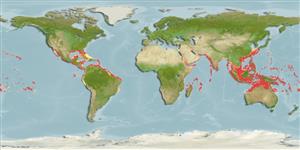Teleostei (teleosts) >
Scombriformes (Mackerels) >
Bramidae (Pomfrets)
Etymology: Brama: Old French, breme, bresme = a fresh water fish; 1460 (Ref. 45335).
More on author: Cuvier.
Environment: milieu / climate zone / depth range / distribution range
Ecology
Marine; pelagic-neritic; oceanodromous (Ref. 51243); depth range 1 - 300 m (Ref. 58302). Deep-water; 31°N - 20°S (Ref. 4936)
Circumtropical. Western Indian Ocean: East Africa to India, between the Equator and 10°S, Mozambique Channel, Seychelles, and Madagascar. Eastern Indian Ocean: Indonesia (Ref. 5978) and Western Australia (Ref. 49596). Western Atlantic: Florida and northern Gulf of Mexico in USA to Brazil (Ref. 7251). Eastern Atlantic: 20°N to 20°S (Ref. 4936). Eastern Pacific: Guatemala to Peru (Ref. 9282) and Chile (Ref. 27363).
Length at first maturity / Size / Weight / Age
Maturity: Lm ?, range 17 - ? cm
Max length : 22.5 cm SL male/unsexed; (Ref. 45034)
Found near the edge of the continental shelf. Appears to spawn all year-round. Marketed fresh, and eaten fried.
An intermittent multiple spawner.
Gomes, J., 1990. Bramidae. p. 758-764. In J.C. Quero, J.C. Hureau, C. Karrer, A. Post and L. Saldanha (eds.) Check-list of the fishes of the eastern tropical Atlantic (CLOFETA). JNCT, Lisbon; SEI, Paris; and UNESCO, Paris. Vol. 2. (Ref. 4936)
IUCN Red List Status (Ref. 130435)
Threat to humans
Harmless
Human uses
Fisheries: commercial
More information
ReferencesAquacultureAquaculture profileStrainsGeneticsElectrophoresesHeritabilityDiseasesProcessingNutrientsMass conversion
Tools
Special reports
Download XML
Internet sources
Estimates based on models
Preferred temperature (Ref.
123201): 18.7 - 28.2, mean 25.9 °C (based on 1189 cells).
Phylogenetic diversity index (Ref.
82804): PD
50 = 0.5039 [Uniqueness, from 0.5 = low to 2.0 = high].
Bayesian length-weight: a=0.01820 (0.00782 - 0.04232), b=2.96 (2.76 - 3.16), in cm total length, based on LWR estimates for this (Sub)family-body shape (Ref.
93245).
Trophic level (Ref.
69278): 3.8 ±0.6 se; based on size and trophs of closest relatives
Resilience (Ref.
120179): High, minimum population doubling time less than 15 months (Preliminary K or Fecundity.).
Fishing Vulnerability (Ref.
59153): Low vulnerability (17 of 100).
